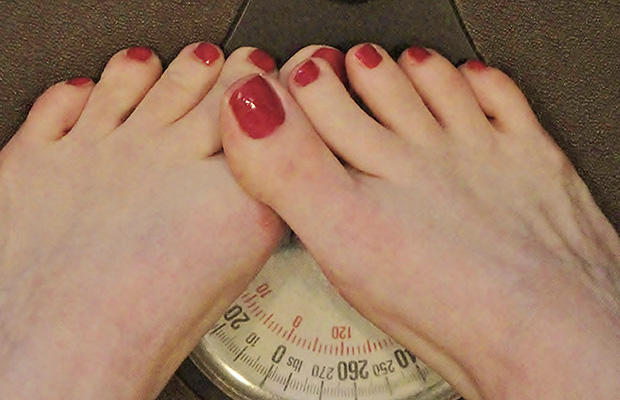How to Create a Weight Loss Chart
Maintaining a healthy weight is a key element of a healthy life generally.[1] Weight gain can pose major medical risks such as heart disease, diabetes, stroke and joint pain.[2] Weighing yourself regularly and keeping track of your weight loss can help you prepare for long term success.[3]
Steps
Method 1 Weighing Yourself
-
1
Weigh yourself regularly. Studies have shown that weighing yourself on a daily basis can help you maintain your weight loss goals. It gives you a regular method for being accountable to yourself.[4]
- Try to weigh yourself every day so you can get a sense of which forms of exercise and nutrition work best for you. [5]
- However, if you have a history of eating disorders such as anorexia or bulimia, do not weigh yourself daily as this can trigger a relapse of your disorder.[6]
-
2
Weigh yourself at the same time every day. Most doctors recommend weighing yourself in the morning as your weight is more likely to fluctuate over the course of the day.[7]
- Wear the same thing when you weigh yourself. It's best if you can weigh yourself while you are naked as heavy shoes, sweaters and other pieces of clothing can contribute to an inaccurate number on the scale.[8]
-
3
Buy a scale. If you want to weigh yourself everyday at home, you need to own a scale. The most common forms of scales are digital scales; these are scales that will produce a numeric value on a tiny screen once you step on them.[9]
- There are also balance beam scales, but you will find that these are taller and bulkier in nature. They might not be the most convenient choice for the average-sized home bathroom.
- You can purchase scales at most home good stores or from web sites like Amazon.
- If you do not want to purchase your own scale, you can also find them at a gym if you have a membership and at some grocery store or drugstore pharmacies.
-
4
Weigh yourself. Step onto the scale. Stand tall with your feet placed parallel, under your hips. After a few seconds, the scale will read the number that represents your weight in pounds.[10]
- Record your weight immediately after weighing yourself so you remember it accurately. You can plot it into your weight loss chart or simply write it down in a nearby journal or piece of paper.[11]
Method 2 Creating a Chart in Excel
-
1
Open a new Excel document. Microsoft Excel is a spreadsheet program that is compatible with PCs and Mac OSx computers and the mobile operating system iOs. It has the ability to make calculations and form graphs and charts based on the data you enter into the spreadsheet.
- Move your cursor to the top two left columns in the spreadsheet. Name the first column "Date" and the second column "Weight." Fill in the date and weight data that you currently weigh. Don't worry if you only have information for one or two days to add to the chart.
- If you want to keep just a simple log of your weight and its corresponding date on which you weighed yourself, you could just use these two columns here to record your progress.
- If you do not have Excel, you can also try using Google Sheets, which is available for free on-line.[12]. You can find it if you type "Google Sheets" into the Google search engine.[13]
-
2
Create a line graph for your weight loss. If you want to take the data you have entered into the date and weight columns and turn it into a line graph chart, you can see the ups and downs in your weight loss journey.
- Open the Excel Fluent Ribbon by going to the Insert tab and then selecting Charts. A number of different chart templates will appear in the upper left corner of the spreadsheet. [14]
- Select the Line option from the different graph options in the menu. As you click on that, a series of different line options to use will appear. Choose the "marked line" graph option.
- Then name the X and Y axis. Find the "Select Option" in the menu bar. You can also right click on the graph and click the "Select Data" option. This will allow you to define the columns you want to include in the chart. It will also allow you to name the X and Y axis.
- 3 Customize your chart. The advantage to creating your own chart is that you can add extra values to it. If you want to measure things such as your heart rate, waist measurement in inches, blood pressure or mood, you can also add these to the chart.[15]
Method 3 Downloading a Weight Loss Chart
-
1
Run a Google search for "weight loss spreadsheet." If you don't want to design your own chart in Excel, you can download some pre-designed Excel templates that will chart your progress.
- Type "weight loss spreadsheet" into your favorite search engine and hit the "search" button. A variety of options will come up.
- You can download these Excel spreadsheets directly onto your computer. All you will need to do is plug in your data (such as height, weight, and the dates) into their corresponding columns.
- If you do not want to fill in your spreadsheets digitally, you can download pre-printed sheets and then manually write in each piece of data.
- 2 Update your spreadsheet regularly. After you have downloaded the spreadsheet, make sure that you continue to use it after you first open it. Set a reminder on your phone or computer to remind you to complete it.
- 3 Save your work. If you are working from a download, you will need to save your work regularly. You might also want to save the spreadsheet to a cloud service such as Dropbox or Google Cloud. Saving it on a cloud will preserve it in case anything happens to your computer.
Method 4 Tracking Your Weight Loss On-Line and On Mobile Devices
-
1
Find an on-line web site where you can track your progress. Many web sites allow you to track not only your weight, but the calories in your food, your mood, your exercise and eating habits.
- Fit Day, My Fitness Pal, and Loseit! are popular options.[16]
- Weight loss web sites often have other communal aspects, such as message boards and blog posts where you can find support and motivation from other users.
-
2
Use a weight loss app on your mobile phone. You might find that you use your phone more regularly than your computer or a hand-written journal. Studies have shown that weight loss apps have had moderate success in helping participants maintain weight loss.[17]
- Depending on your phone's operating system (Apple or Android), you can use iTunes or Google Playstore to search for weight loss apps. Popular options include My Fitness App, Locavore, and Endomondo.[18]
- 3 Streamline your needs. The advantage to on-line web sites and apps is that they can track multiple aspects of your weight loss, not just the pounds that you lose or gain. You are more likely to hold yourself accountable if you have just one place where you can keep all of your information.
-
Established Methods For Safe Weight Loss
There are many ways to lose weight, some good and some not so good. Y
-
Starting to lift weights - Part 1
Now that fall is in full swing and the baseball playoffs are win
-
Everything You Always Wish You’d Known About Weight Loss
Weight loss can make you happier with what you see in the mirror,
-
This Is What Happens To Your Body When You Skip Meals
The claim: Just a few days of fasting can trigger the breakdown of ske
-
Weight Loss Tip #25 – Eat flaxseeds to lose weight
-
Weight Loss Tips | Losing Weight Without Losing Your Mind
Millions of Americans struggle each day to lose weight and gain confi
- DON'T MISS
- Weight Loss Tips And Loss Weight At Home
- 6 Tips For A Healthy Weight Loss Diet
- 12 Diet Questions Answered
- 5 Great Tips On Losing Weight
- How to Go on the Cabbage Soup Diet
- Healthy Ways To Lose Weight
- Does Alli Work?
- Liposuction: A Surgical Way To Weight Loss
- Yoga Exercises For Weight Loss: The Best Way To Healthy & Fit Life
- How To Lose 10 Pounds After Menopause




